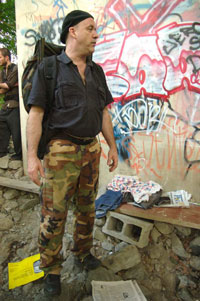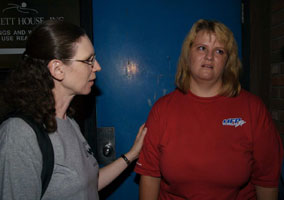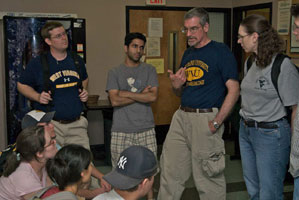|
November/December 2007 Issue Multidisciplinary Homeless Outreach — The Big Picture
The Multidisciplinary Unsheltered Homeless Relief Outreach of Morgantown, or Project MUSHROOM, conceived through the zeal of medical students and faculty sponsored by Dave Deci, MD, of the department of family medicine at West Virginia University (WVU), attempts to address these concerns. “Upward of 60% to 70% of clients struggle with mental health, alcohol, and substance abuse issues,” says Deci. “That would be the major area. Those issues impact the more traditional medical problems. Many of our clients have liver-related diseases due to alcoholism or dual diagnoses that lead to other kinds of dependencies, like nicotine dependency. We see a lot of respiratory problems. Superimposed on that is the general background noise of medical problems that are common to everyone: diabetes, high blood pressure, asthma, and cardiovascular diseases.” Rounding out the medical presentation are problems related to environmental exposure: bug bites, poison ivy, burns from cooking fires, frostbite in the winter, and sunburn in the summer.
Deci has come to value social workers as part of the MUSHROOM team. “Social work has been so invaluable. As team members, what you soon come to realize is that we see people and situations with different eyes. We come from different training and different backgrounds,” he says. “One thing that is so wonderful is the social work perspective of care. We are focused on, ‘Oh my goodness, they are going to get frostbite.’ And the social worker is saying, ‘We really need to see how to get this person into stable housing.’ … In many cases, these professionals are much more life-sustaining than any kind of medicine or medical treatment we could provide.” Building Trust
MUSHROOM makes street rounds providing basic medical care, support, and triage to people living on the street. The Homeless Care Clinic (HCC), staffed by an attending physician, a clinical psychologist, and a social worker, picks up where MUSHROOM leaves off. Jeannie Sperry, the clinical psychologist for the HCC, treated a patient who illustrates this interface. She recalls: “There was a man displaced by Hurricane Katrina. … He lost everything in the hurricane and really had nothing to go back to. ... He relapsed into alcoholism because of his depression and being away from his job and everything he knew. He lost his apartment and ended up living on the street. He was seen by MUSHROOM folks and helped to get into Bartlett House. Then, he was referred to the Homeless Care Clinic. He has hepatitis C from previous drug use, so his use of alcohol was particularly troublesome because of the possibility of organ failure. Through HCC, we began treating his depression with medication and brief therapy. He was seen briefly every week for several weeks. When his depression was stabilized, we were able to help get him into alcohol recovery treatment. He spent some time [as an] in-patient and was in a halfway house. He obtained employment. When his alcoholism and depression are kept under wraps, he has a better ability to maintain work because the hepatitis C leaves him pretty fatigued if he is also depressed and drinking. He is now employed and in stable housing.” Deci views this as a great continuum of care. “The beauty is the street outreach with MUSHROOM on every other Tuesday, and on Wednesday, they can go to the clinic and get more sophisticated care—blood work, x-rays—and if they have chronic problems, they can get linked into more permanent medical care,” he explains. According to Deci and Sperry, the HCC is a link to a higher level of care. HCC patients are accepted without medical or insurance cards and with limited ID. They can receive services that are difficult to get living on the street, such as Pap smears, neonatal care, immunizations, psychological assessment, brief therapy, and referrals to hospitals and specialty clinics. Non-medical needs are addressed through interventions, such as finding stable housing, help getting HUD vouchers, and other forms of social assistance. Multidisciplinary street outreach linked to a supporting multidisciplinary drop in clinic enhances the quality of healthcare for the homeless. — Neal A. Newfield, PhD, ACSW, is an associate professor of social work and a documentary photographer with the division of social work at West Virginia University. References Hwang, S.W., Orav, E.J., O’Connell, J.J., Lebow, J.M., & Brennan, T.A. (1997). Causes of death in homeless adults in Boston. Annals of Internal Medicine, 126(8), 625-628. McCary, J.M. & O’Connell, J.J. (2005). Health, housing, and the heart: Cardiovascular disparities in homeless people. Circulation, 111(20),2555-2556. |

 According to some estimates, nearly 3 million people are homeless in the United States (Hwang, 1997). The mortality rate among the homeless is three to five times higher than the general population (McCary & O’Connell, 2005). The prevalence of diseases such as tuberculosis, HIV, and substance abuse is also higher, and people who are homeless, on average, die in their 40s, based on studies conducted in several large cities (Hwang, 1997).
According to some estimates, nearly 3 million people are homeless in the United States (Hwang, 1997). The mortality rate among the homeless is three to five times higher than the general population (McCary & O’Connell, 2005). The prevalence of diseases such as tuberculosis, HIV, and substance abuse is also higher, and people who are homeless, on average, die in their 40s, based on studies conducted in several large cities (Hwang, 1997). Project MUSHROOM, modeled after Pittsburgh’s Operation Safety Net developed by James Withers, MD, of Mercy Hospital, is multidisciplinary because treatment is conceived as having a strong nonmedical component, as well as both a micro and macro focus. Care is not just medical treatment but also advocacy, motivating and educating the community to address the larger issues of affordable housing, a living wage, improvements in the welfare safety net, and healthcare for the uninsured.
Project MUSHROOM, modeled after Pittsburgh’s Operation Safety Net developed by James Withers, MD, of Mercy Hospital, is multidisciplinary because treatment is conceived as having a strong nonmedical component, as well as both a micro and macro focus. Care is not just medical treatment but also advocacy, motivating and educating the community to address the larger issues of affordable housing, a living wage, improvements in the welfare safety net, and healthcare for the uninsured.  Sonntag reiterates a common theme of Project MUSHROOM: healthcare provision to the homeless requires that the services be delivered within a social relationship. “A lot of clients that are out there, it is not that they do not want help, but they are too scared and nervous to seek help. Often, it takes months for clients to have the trust to be able to accept help from Project MUSHROOM,” she explains. “Last night, I walked into one of the back rooms of the Bartlett House [a homeless shelter] to see if anyone was back there, and there was a new lady who has only been there for a couple of weeks. One of the gentlemen who was sitting there with her said, ‘Oh, don’t worry, this is a MUSHROOM person. You can trust her. She is fine. You can talk to her.’ That reputation precedes MUSHROOM.”
Sonntag reiterates a common theme of Project MUSHROOM: healthcare provision to the homeless requires that the services be delivered within a social relationship. “A lot of clients that are out there, it is not that they do not want help, but they are too scared and nervous to seek help. Often, it takes months for clients to have the trust to be able to accept help from Project MUSHROOM,” she explains. “Last night, I walked into one of the back rooms of the Bartlett House [a homeless shelter] to see if anyone was back there, and there was a new lady who has only been there for a couple of weeks. One of the gentlemen who was sitting there with her said, ‘Oh, don’t worry, this is a MUSHROOM person. You can trust her. She is fine. You can talk to her.’ That reputation precedes MUSHROOM.”